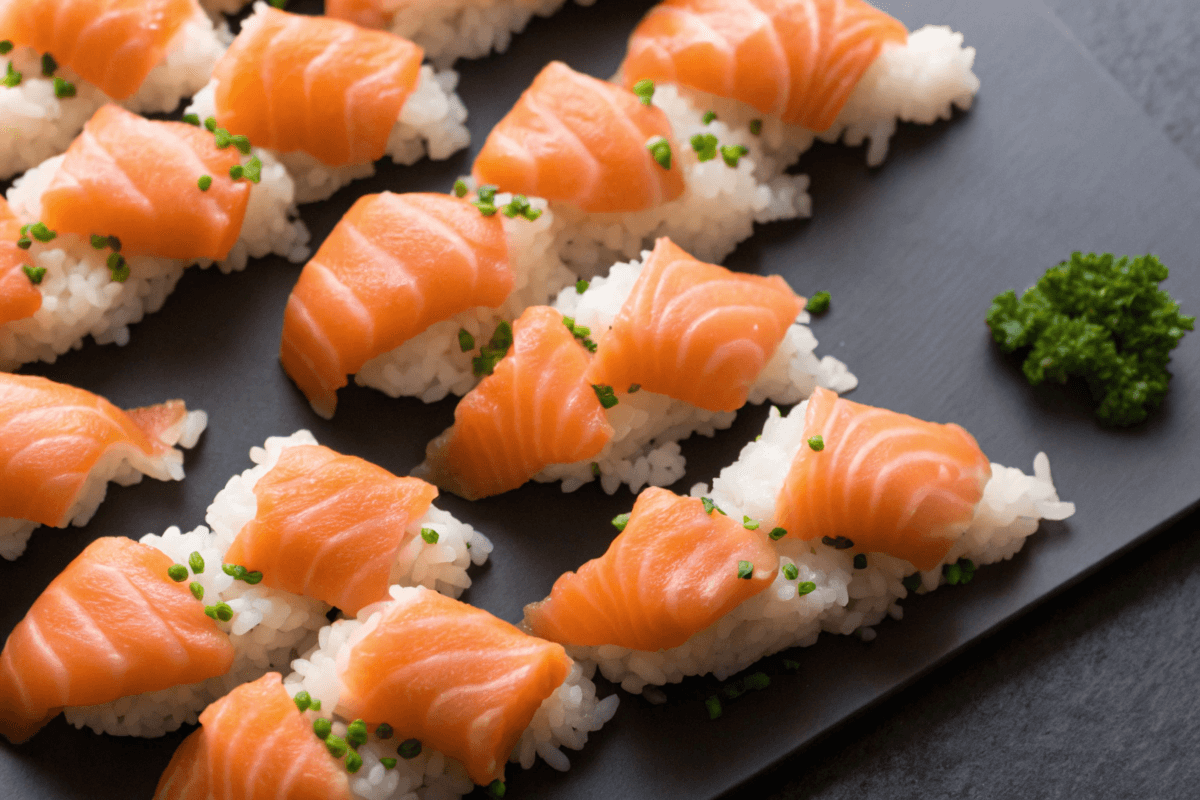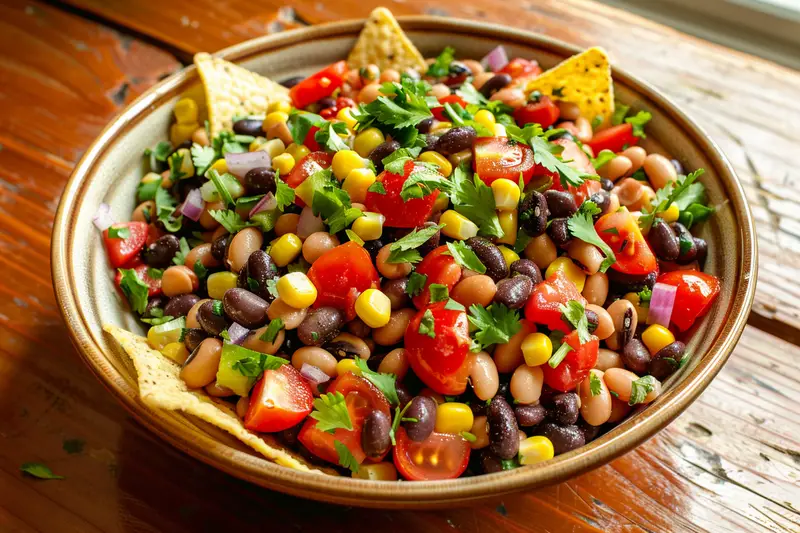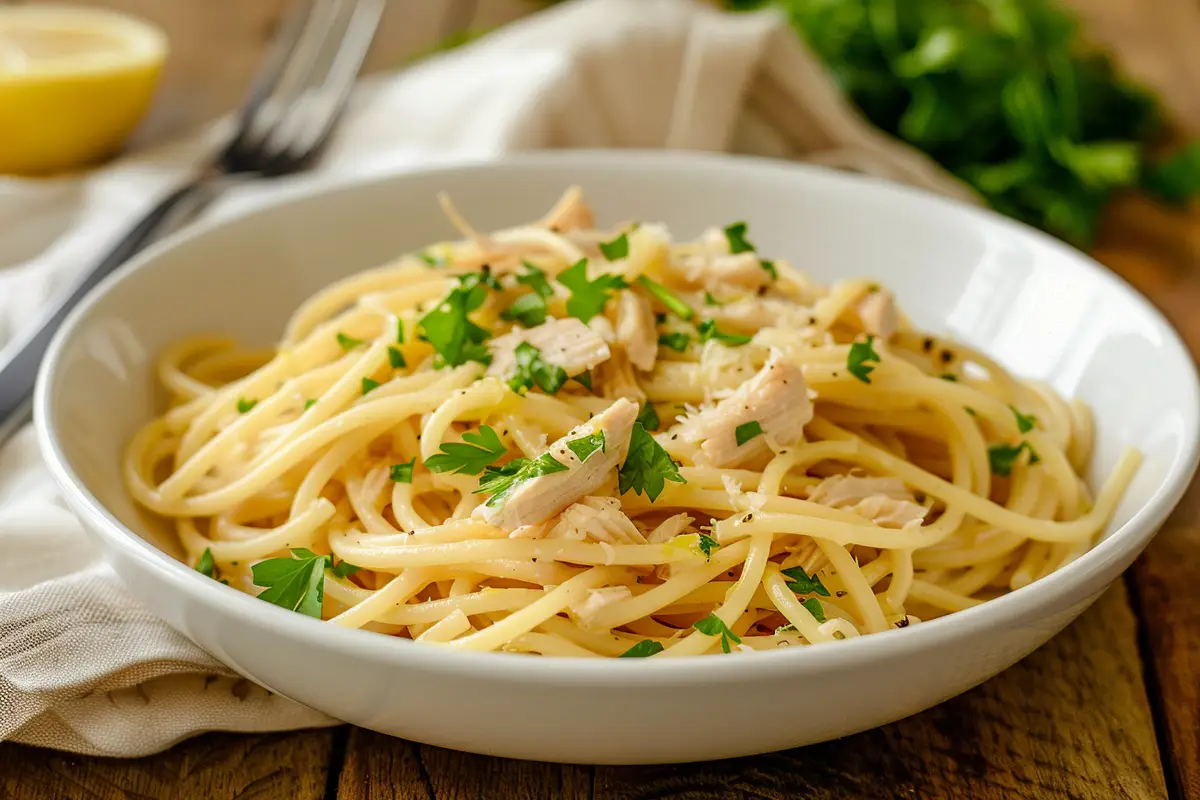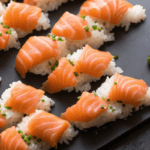
Salmon Sushi – A Complete Guide to the Iconic Japanese Dish
Description
Recipe Description: Salmon sushi is a beloved Japanese dish that combines the rich, buttery flavor of fresh salmon with seasoned sushi rice. This recipe guides you through creating nigiri and maki rolls, allowing you to enjoy restaurant-quality sushi at home.
Ingredients
Ingredients:
- 200 grams sushi-grade fresh salmon, chilled
- 2 cups cooked sushi rice (short-grain preferred)
- 3–4 sheets of nori (seaweed), cut in half for rolling
- 3 tablespoons rice vinegar
- 1 tablespoon sugar
- 1 teaspoon salt
- Wasabi, as desired (optional)
- Soy sauce, for serving
- Optional fillings: avocado, cucumber, cream cheese
Instructions
Instructions:
Prepare the Sushi Rice:
- Rinse the rice thoroughly to remove excess starch. Cook according to package instructions.
- In a small saucepan, heat rice vinegar, sugar, and salt until dissolved. Fold this mixture into the cooked rice while it’s still warm.
Slice the Salmon:
- Use a sharp knife to cut the salmon into thin, even slices for nigiri or sashimi. For rolls, cut into strips.
Assemble Nigiri:
- Shape small mounds of rice and place a slice of salmon on top.
Assemble Maki Rolls:
- Lay a sheet of nori on a bamboo mat, spread rice evenly, and add salmon and optional fillings. Roll tightly using the mat.
Serve:
- Plate your creations with wasabi, pickled ginger, and soy sauce on the side.
Notes
Preparation Time: 30 minutes
Cooking Time: 20 minutes
Total Time: 50 minutes
Serving Size: 2 servings
Yield: Approximately 12 pieces
Cuisine: Japanese
Course: Main Course
Nutrition Information (per serving):
- Calories: 350
- Fat: 10g
- Carbohydrates: 45g
- Protein: 20g
Featured Image: A beautifully arranged platter of salmon nigiri and maki rolls, garnished with pickled ginger, wasabi, and soy sauce on the side.
Additional Notes:
- Ensure you use sushi-grade salmon, which is flash-frozen to eliminate parasites and ensure safety.
- For added variety, consider incorporating fillings like avocado, cucumber, or cream cheese into your rolls.
- Serve with pickled ginger and wasabi to enhance the flavors.
Salmon sushi is a culinary masterpiece that has captured the hearts of food enthusiasts worldwide. This iconic dish combines the freshness of premium salmon with perfectly seasoned rice, wrapped in seaweed or served as delicate slices atop rice or on their own. Whether you are a sushi aficionado or a beginner exploring Japanese cuisine, this guide is your ultimate resource for mastering salmon sushi at home. Packed with tips, recipes, and answers to frequently asked questions, it’s time to dive into the world of salmon sushi.
Table of Contents
What Is Salmon Sushi?
The Unique Appeal of Salmon Sushi
Salmon sushi stands out for its versatility and unparalleled flavor. It combines the buttery richness of fresh salmon with the umami-packed flavors of sushi rice and nori. Whether served raw, smoked, or lightly seared, salmon is a top choice for sushi lovers due to its soft texture and delicate taste.
Historically, sushi was crafted with various types of fish, but salmon became a staple in the late 20th century when its use was popularized globally. Its unique flavor profile and high nutritional value, rich in omega-3 fatty acids, have made it a favorite in sushi bars worldwide.
Varieties of Salmon Sushi
There’s more to salmon sushi than meets the eye. Some popular types include:
- Nigiri: Slices of salmon elegantly placed atop hand-formed mounds of seasoned rice.
- Rolls (Maki): Nori-wrapped rice filled with salmon and other ingredients like avocado or cucumber.
- Sashimi: Thin slices of raw salmon served without rice, often accompanied by daikon radish.
- Temaki: Hand-rolled cones of nori stuffed with salmon, rice, and other fillings.
Each variety offers a unique way to enjoy the delightful flavors of salmon.
Ingredients and Recipe for Salmon Sushi
You’ll need a few essential ingredients to make salmon sushi at home. Each component contributes to the dish’s authenticity and flavor.
Essential Ingredients
Here’s a breakdown of what you’ll need:
| Ingredient | Amount | Notes |
|---|---|---|
| Fresh salmon | 200 grams | Sushi-grade, chilled |
| Sushi rice | 2 cups (cooked) | Short-grain preferred |
| Nori sheets | 3-4 sheets | Cut in half for rolling |
| Rice vinegar | 3 tablespoons | Seasoning for the rice |
| Sugar | 1 tablespoon | Mix with vinegar |
| Salt | 1 teaspoon | For rice seasoning |
| Wasabi | As desired | Optional, for added spice |
| Soy sauce | For serving | Traditional dipping sauce |
| Optional fillings | To taste | Avocado, cucumber, cream cheese |
Step-by-Step Recipe
- Prepare the Sushi Rice
- Rinse the rice thoroughly to remove excess starch. Cook according to package instructions.
- Heat rice vinegar, sugar, and salt in a small saucepan until dissolved. Fold this mixture into the cooked rice while it’s still warm.
- Slice the Salmon
- Use a sharp knife to cut the salmon into thin, even slices for nigiri or sashimi. For rolls, cut into strips.
- Assemble Your Sushi
- For nigiri, shape small mounds of rice and place a slice of salmon on top.
- For rolls, lay a sheet of nori on a bamboo mat, spread rice evenly, and add salmon and fillings. Roll tightly using the mat.
- For sashimi, simply arrange slices on a plate with garnish.
- Serve
- Plate your creations with wasabi, pickled ginger, and soy sauce on the side.

Is Salmon Sushi Raw?
Raw salmon is a hallmark of authentic sushi, offering a fresh and clean taste. However, not all salmon can be consumed raw. When making sushi at home, ensure you use sushi-grade salmon, which is flash-frozen to eliminate parasites and ensure safety.
What Is Sushi-Grade Salmon?
Sushi-grade salmon meets strict safety standards, ensuring it’s safe to eat raw. Look for labels like “sashimi-grade” or “sushi-grade” when shopping. Additionally, consider trusted fishmongers for the freshest selection.
For those hesitant about raw fish, alternatives, like smoked or seared salmon, are excellent options that retain the dish’s essence while offering a unique flavor twist.
What Does a Salmon Roll Contain?
Salmon rolls, or maki, are among the most popular types of sushi. A typical salmon roll includes:
- Sushi rice
- Nori (seaweed)
- Fresh salmon slices or strips
- Optional fillings like avocado, cucumber, or cream cheese
Variations of Salmon Rolls
- Spicy Salmon Roll: Adds a kick with spicy mayo or sriracha.
- Philadelphia Roll: Combines salmon, cream cheese, and cucumber for a creamy texture.
- Dragon Roll: Features salmon with toppings like avocado for an artistic presentation.
By experimenting with fillings and sauces, you can create endless variations.
While preparing your sushi, explore delicious baked salmon recipes to add versatility to your salmon dishes. For a complete meal, pair your sushi with options from what is a good side dish with salmon to enhance your dining experience.
The art of making salmon sushi lies in the details, from choosing the freshest fish to perfecting the rice’s seasoning. With this guide, you’re well on your way to mastering this iconic dish, transforming simple ingredients into a culinary delight.
Salmon sushi, a beloved staple in Japanese cuisine, has become a global phenomenon. Its delicate flavor, smooth texture, and artistic presentation make it a standout dish for sushi enthusiasts and novices alike. This guide delves into the world of salmon sushi, exploring its varieties, preparation techniques, and tips to help you recreate this culinary delight at home. Whether you’re curious about its origins, interested in mastering the art of sushi-making, or simply seeking the perfect recipe, this guide has you covered.
What Is Salmon Sushi?
Why Salmon Sushi Is So Popular
Salmon sushi is known for its exquisite balance of flavors and textures. The creamy richness of the salmon, the vinegared tang of sushi rice, and the crispness of nori come together to create a harmonious bite. Its widespread appeal lies in its versatility—it can be enjoyed raw, lightly seared, or smoked and pairs beautifully with an array of ingredients.
Initially, raw salmon wasn’t traditionally used in Japanese sushi due to parasite concerns. However, thanks to advancements in freezing techniques and the influence of Norwegian salmon exports in the 1980s, raw salmon gained popularity and became a sushi staple worldwide.
Types of Salmon Sushi
Salmon sushi offers a variety of styles, each with unique characteristics:
- Nigiri: Thin slices of salmon are draped over hand-formed rice, sometimes enhanced with a dab of wasabi or a brush of soy sauce.
- Maki (Rolls): Salmon, along with other fillings, is wrapped in rice and nori, creating compact, flavorful rolls.
- Sashimi: Purely salmon, sliced thinly, served without rice to highlight its natural taste.
- Temaki (Hand Rolls): Salmon and other ingredients are wrapped into cone-shaped rolls, perfect for casual dining.
Each type allows for creative customization, catering to various preferences and occasions.
Ingredients and Recipe for Salmon Sushi
Essential Ingredients
Creating salmon sushi at home starts with high-quality ingredients. Freshness and proper preparation are critical to achieving the best results.
| Ingredient | Amount | Notes |
|---|---|---|
| Fresh salmon | 200 grams | Sushi-grade, properly frozen |
| Sushi rice | 2 cups (cooked) | Use short-grain rice for stickiness |
| Nori sheets | 3-4 sheets | Crisp and evenly cut |
| Rice vinegar | 3 tablespoons | For seasoning the rice |
| Sugar | 1 tablespoon | Balances the vinegar’s acidity |
| Salt | 1 teaspoon | Enhances the flavor |
| Soy sauce | For serving | Adds umami when dipped |
| Wasabi | As desired | Optional for a spicy kick |
| Garnishes | To taste | Avocado, cucumber, or sesame seeds |
Step-by-Step Instructions
1. Prepare the Sushi Rice
Start by rinsing the rice thoroughly to remove excess starch, ensuring a light and fluffy texture. Cook the rice according to the package instructions, then season with a mixture of rice vinegar, sugar, and salt. Fold gently to avoid breaking the grains, and let the rice cool to room temperature.
2. Slice the Salmon
Cut the salmon into slices or strips using a sharp knife, depending on your sushi style. For nigiri and sashimi, precision is key—aim for thin, even slices. For rolls, cut into strips about half an inch wide.
3. Assemble the Sushi
- Nigiri: Form small mounds of rice with your hands and top with a slice of salmon.
- Rolls: Lay a sheet of nori on a bamboo mat, spread rice evenly, and layer salmon and fillings. Roll tightly with the mat and slice into bite-sized pieces.
- Sashimi: Arrange salmon slices with garnishes like shredded daikon radish on a plate.
4. Serve
Serve your sushi with soy sauce, wasabi, and pickled ginger. Pair with miso soup or green tea for a complete Japanese dining experience.
Is Salmon Sushi Raw?
The Raw Appeal
Raw salmon is celebrated for its buttery texture and clean taste, making it a sushi favorite. However, not all salmon is suitable for raw consumption. Sushi-grade salmon undergoes rigorous processing, including freezing at ultra-low temperatures to eliminate parasites, ensuring it is safe to eat.
What If You Prefer Cooked Salmon?
For those hesitant about raw fish, cooked options offer a delightful alternative. Smoked salmon adds a rich, savory flavor, while lightly seared salmon (aburi) provides a caramelized surface with a tender center. Both variations maintain the essence of salmon sushi while offering unique textures and tastes.
What Does a Salmon Roll Contain?
Classic Ingredients
A traditional salmon roll typically includes sushi rice, nori, fresh salmon, and complementary fillings such as avocado or cucumber. These ingredients are layered and rolled tightly to create the perfect bite.
Popular Variations
- Spicy Salmon Roll: Features spicy mayo and scallions for added heat and flavor.
- Philadelphia Roll: Combines cream cheese, cucumber, and salmon for a creamy, tangy twist.
- Dragon Roll: Includes layers of avocado and salmon, often topped with tobiko (fish roe) for added texture.
Customization Tips
To personalize your rolls:
- Experiment with alternative fillings like mango, tempura flakes, or spicy tuna.
- Add a drizzle of unagi sauce for a sweet-savory glaze.
- Sprinkle toasted sesame seeds or scallions for added texture and aroma.
For more salmon-centric dishes, check out delicious baked salmon recipes. If you’re planning a sushi night, consider pairing your meal with these ideal side dishes for salmon to elevate your dining experience.
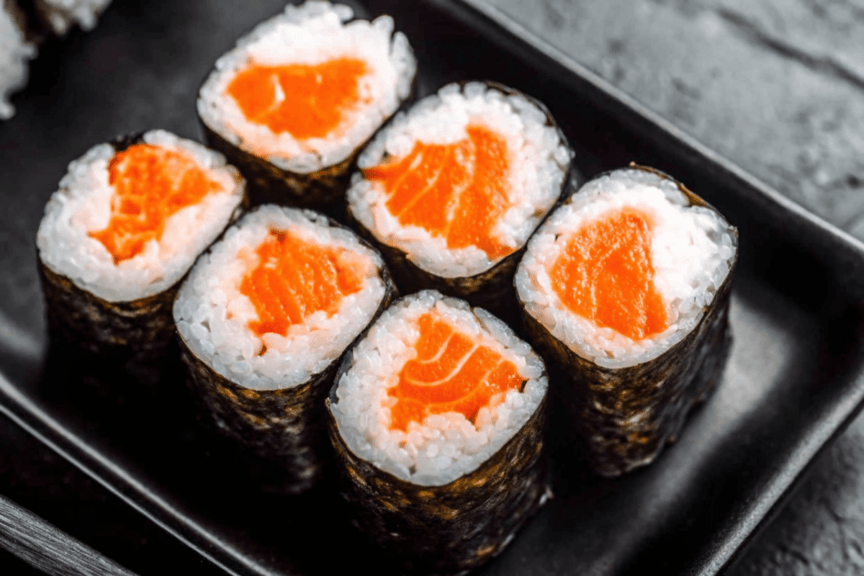
Salmon sushi is not just a meal but an art form inviting creativity and exploration. With the right ingredients, tools, and a little practice, you can bring the authentic flavors of Japan to your table, creating a memorable experience for family and friends.
Pro Tips & Variations for Salmon Sushi
Enhancing the Sushi Experience
Making salmon sushi at home offers endless opportunities for creativity. Adding unique twists and focusing on the presentation can elevate your sushi to restaurant-quality standards.
1. Experiment with Presentation
The visual appeal of sushi is as important as its taste. Arrange your sushi on elegant plates with contrasting garnishes, such as pickled ginger or edible flowers. A bamboo sushi mat ensures your rolls are tight and uniform, creating a polished look.
2. Innovative Toppings and Fillings
Explore different flavor combinations:
- Aburi Salmon: Lightly sear salmon with a kitchen torch to create a smoky, caramelized exterior while maintaining its tender center.
- Unique Fillings: Try incorporating mango, jalapeños, or pickled vegetables for unexpected bursts of flavor.
- Drizzles and Sprinkles: Finish your rolls with spicy mayo, eel sauce, or sesame seeds for added texture and taste.
3. Incorporating Crunch
The texture is key to a memorable sushi experience. Add tempura flakes, crispy onions, or thinly sliced cucumbers for a satisfying crunch.
FAQs About Salmon Sushi
What Is the Salmon Sushi Called?
Salmon sushi encompasses various styles, each with its own name and presentation:
Nigiri: A hand-shaped mound of rice topped with a slice of salmon.
Maki: Rolls featuring salmon, rice, and other fillings wrapped in nori.
Sashimi: Thin slices of raw salmon served without rice, showcasing its pure flavor.
Is Salmon in Sushi Raw?
Typically, yes, salmon in sushi is raw. However, it must be sushi-grade, meaning it has been frozen to eliminate parasites and is safe for raw consumption. For those who prefer cooked options, smoked or lightly seared salmon are excellent alternatives.
What Does a Salmon Roll Have?
A classic salmon roll contains sushi rice, fresh salmon, and nori. Variations often include fillings like avocado, cucumber, or cream cheese, with toppings such as sesame seeds or spicy mayo.
Is Salmon Sashimi Just Salmon?
Yes, salmon sashimi is raw salmon served in thin slices. Unlike sushi, sashimi does not include rice. It emphasizes the fish’s natural flavor and texture, often accompanied by wasabi, soy sauce, or pickled vegetables.
What Side Dishes Pair Well with Salmon Sushi?
Pairing sushi with side dishes like miso soup, edamame, or seaweed salad enhances the dining experience. Additionally, consider including light appetizers like gyoza or tempura for variety.
Can You Use Frozen Salmon for Sushi?
Yes, but it must be labeled as sushi-grade and frozen according to strict standards to ensure safety. Thaw the salmon in the refrigerator before use to preserve its quality.
Conclusion
Salmon sushi is a delightful blend of tradition, creativity, and flavor. From classic nigiri and maki rolls to innovative variations like aburi, this dish offers endless opportunities to explore Japanese cuisine. You can create sushi that rivals the best sushi bars by using fresh ingredients, mastering simple techniques, and experimenting with new flavors.
Whether you’re hosting a sushi night or simply indulging in your culinary passions, salmon sushi is a dish that never fails to impress. So, gather your tools, source high-quality ingredients, and embark on your sushi-making journey today!

